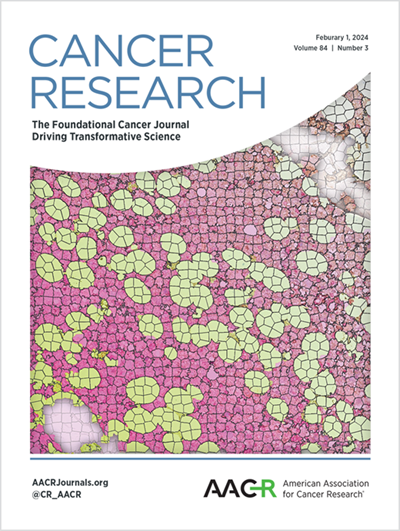Multi-omic Characterization of Pre- and Post-neoadjuvant Chemotherapy Treated Ovarian Cancer Reveals Mediators of Tumorigenesis and Chemotherapy Response
IF 12.5
1区 医学
Q1 ONCOLOGY
引用次数: 0
Abstract
High-grade serous ovarian cancer (HGSC) accounts for more than 200,000 deaths each year. Despite recent advances in treating HGSC with neoadjuvant chemotherapy, the majority of patients ultimately develop chemotherapy resistance. HGSC is characterized by TP53 mutations and widespread copy number alterations and occurs frequently in the setting of deleterious germline BRCA1/2 variations, but many cases lack putative driver mutations. Here, we performed whole-exome, whole-genome, and whole transcriptome sequencing along with mass spectrometry to characterize the molecular landscape of HGSC in 22 paired samples obtained before and after neoadjuvant chemotherapy. Responsiveness to chemotherapy was determined for each patient. Evidence at the DNA, RNA, and protein level revealed numerous defects in cell-cell and cell-matrix interactions as well as disruption of cell polarity and cytoskeletal regulation in HGSC, indicating that defects in epithelial integrity were present in the majority of HGSC patients. Non-responsive HGSC harbored subclones with putative survival mutations. Additionally, ineffective nonsense mediated decay resulted in the persistence of transcripts with frameshift mutations that were translated into aberrant proteins detectable in HGSC samples. Together, these findings suggest that HGSC may arise through defects in maintenance of epithelial integrity that lead to shedding of malignant cells throughout the peritoneum, and the presence of resistant subclones prior to chemotherapy may decrease the chemosensitivity of patients.卵巢癌新辅助化疗前后的多组学特征揭示了肿瘤发生和化疗反应的介质
高级别浆液性卵巢癌(HGSC)每年造成20多万人死亡。尽管最近在用新辅助化疗治疗HGSC方面取得了进展,但大多数患者最终会产生化疗耐药性。HGSC的特征是TP53突变和广泛的拷贝数改变,并且经常发生在有害的种系BRCA1/2变异的环境中,但许多病例缺乏假定的驱动突变。在这里,我们进行了全外显子组、全基因组和全转录组测序以及质谱分析,以表征在新辅助化疗前后获得的22对样本中的HGSC的分子景观。确定每位患者对化疗的反应性。DNA、RNA和蛋白质水平的证据显示,在HGSC中,细胞-细胞和细胞-基质相互作用中存在许多缺陷,以及细胞极性和细胞骨架调节的破坏,表明上皮完整性缺陷存在于大多数HGSC患者中。无应答的造血干细胞窝藏着具有假定存活突变的亚克隆。此外,无效的无义介导的衰变导致具有移码突变的转录本的持久性,这些突变被翻译成HGSC样品中可检测到的异常蛋白。总之,这些发现表明,HGSC可能是由于维持上皮完整性的缺陷导致恶性细胞在整个腹膜中脱落而产生的,并且化疗前耐药亚克隆的存在可能会降低患者的化疗敏感性。
本文章由计算机程序翻译,如有差异,请以英文原文为准。
求助全文
约1分钟内获得全文
求助全文
来源期刊

Cancer research
医学-肿瘤学
CiteScore
16.10
自引率
0.90%
发文量
7677
审稿时长
2.5 months
期刊介绍:
Cancer Research, published by the American Association for Cancer Research (AACR), is a journal that focuses on impactful original studies, reviews, and opinion pieces relevant to the broad cancer research community. Manuscripts that present conceptual or technological advances leading to insights into cancer biology are particularly sought after. The journal also places emphasis on convergence science, which involves bridging multiple distinct areas of cancer research.
With primary subsections including Cancer Biology, Cancer Immunology, Cancer Metabolism and Molecular Mechanisms, Translational Cancer Biology, Cancer Landscapes, and Convergence Science, Cancer Research has a comprehensive scope. It is published twice a month and has one volume per year, with a print ISSN of 0008-5472 and an online ISSN of 1538-7445.
Cancer Research is abstracted and/or indexed in various databases and platforms, including BIOSIS Previews (R) Database, MEDLINE, Current Contents/Life Sciences, Current Contents/Clinical Medicine, Science Citation Index, Scopus, and Web of Science.
 求助内容:
求助内容: 应助结果提醒方式:
应助结果提醒方式:


